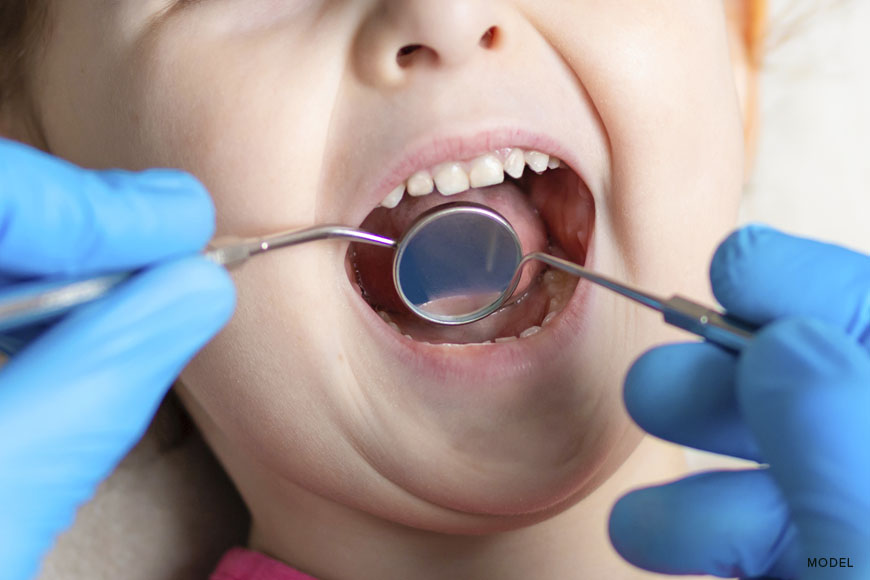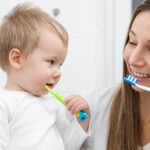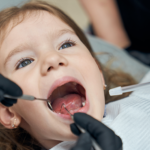Fortunately, pediatric dental practices can utilize different types of dental sedation for kids to help alleviate anxiety and stress from children’s dental procedures. Dental visits can be a source of anxiety for kids, causing distress for both them and their parents. Understanding and addressing dental anxiety ensures a positive oral health experience for young ones and promotes a long-term positive relationship to oral hygiene.
Understanding Dental Anxiety in Kids
Dental anxiety in kids is a common phenomenon usually stemming from the unfamiliar environment, the presence of strangers, and the sounds of dental equipment which can trigger anxiety in children. It is best to discuss dental appointments in a positive light and introduce children to the idea with optimism prior to the appointment.
Familiarity with the surroundings and the dental team helps ease anxieties in children. Your provider will introduce themselves in order to build familiarity and ease in comfort. This is why establishing a consistent dental routine and introducing children to dental visits at an early age can also help reduce anxiety and, prevent dental phobia from developing.
Empowering Comfort through Sedation Dentistry
Sedation dentistry is a specialized approach that aims to create comfort during dental treatments, ensuring a positive experience for kids. The process involves using medication such as nitrous oxide, general anesthesia, or laughing gas to help children relax during dental procedures. The primary purpose is to alleviate anxiety, allowing the dentist to work more effectively while keeping the child comfortable.
Sedation dentistry offers several benefits, including:
- Pain Relief: Sedation reduces discomfort, making procedures less painful for the child, even in minor tooth surgery.
- Effective Treatment: Dentists can perform treatments more efficiently when the child is calm and cooperative.
- Positive Experience: Positive experiences foster a healthier attitude toward dental care in the future.
Types of Sedation for Kids
Pediatric dentistry often uses different levels of sedation to ensure comfort and safety for young patients during dental procedures. Understanding these different levels of sedation is essential for clinicians and parents to make informed decisions about the child’s care.
Here are the different levels of sedation commonly used in pediatric dentistry:
-
Minimal Sedation
Method: Nitrous oxide (laughing gas) is the most common agent used for minimal sedation. It’s mixed with oxygen and inhaled through a mask.
Effects: The child remains awake, relaxed, and cooperative. Anxiety is reduced, and they might feel a bit drowsy.
Recovery: Rapid recovery, and the effects wear off soon after the mask is removed. -
Moderate Sedation (Conscious Sedation)
Methods: Can be administered orally (e.g., a syrup), intranasally, or intravenously (IV). Common agents include midazolam, chloral hydrate, and hydroxyzine.
Effects: The child becomes drowsy and may even doze off but can be easily awakened. They may not remember the procedure afterward.
Recovery: It may take longer to recover compared to minimal sedation. Monitoring is required until the child is fully alert. -
Deep Sedation
Method: Administered intravenously or through inhalation.
Effects: The child will be on the edge of consciousness but can still be awakened. It’s deeper than moderate sedation, and the child is less likely to remember the procedure.
Recovery: The child requires close monitoring during recovery. There’s a potential for respiratory or cardiovascular effects, so it’s vital to have resuscitative equipment and trained personnel on hand. -
General Anesthesia
Method: Administered through inhalation or intravenous routes. An anesthesiologist or dental anesthetist typically supervises it.
Effects: The child will be entirely unconscious and won’t feel or remember anything about the procedure.
Recovery: The child requires close monitoring in a recovery area. It takes longer for the child to wake up and be ready for discharge. As with deep sedation, it’s essential to have the necessary equipment and personnel for resuscitation.
Choosing the appropriate level of sedation is a decision made based on the procedure’s invasiveness, the child’s age, the child’s level of anxiety, any underlying medical conditions, and the anticipated cooperation of the child. Parents and guardians should always be thoroughly informed about the risks and benefits of the chosen sedation level and provide informed consent before the procedure.
Determining When Kids Should Be Sedated
Kid’s dental procedures vary. While some may not require sedation, others may require extensive sedatives. A pediatric dentist will help you assess if sedation is appropriate and what method is best to use. It is important to tailor the experience to each child with an analysis of their background, a determination of what approach is best to use, and what the desired results are. Children with anxiety may need sedatives as well as young children who may require extensive work to be done. Special needs, and inability to cooperate are also taken into consideration when taking this step.
Your dental provider may also introduce behavioral and relaxation techniques to pre-empt or totally avoid sedation such as introducing breathing techniques, toys, and entertainment.
Dental sedation for kids is usually required for the following reasons:
Severe Dental Anxiety
In cases of severe dental anxiety, children may exhibit physical symptoms such as increased heart rate, excessive sweating, and even panic attacks. Dental sedation for kids helps alleviate their stress and fear. By administering sedatives, the child is able to relax and feel more at ease during the procedure. This not only benefits the child’s mental and emotional well-being but also allows the dentist to perform necessary treatments with greater precision.
Young Children Needing Extensive Work
For young children who require extensive oral surgical procedures, such as multiple tooth surgeries or intricate oral surgeries, sedation dentistry plays a vital role. These procedures can be lengthy and potentially uncomfortable for a child, especially if they are too young to fully understand what’s happening. Dental sedation for kids ensure their comfort throughout the procedure, enabling the dentist to complete the necessary work without causing distress to the child. This approach prevents traumatic experiences that could lead to dental anxiety in the future.
Children with Special Needs
Children with special needs often have unique challenges when it comes to receiving dental care. They might struggle with sensory sensitivities, communication difficulties, or difficulty sitting still. Dental sedation for kids with special needs is tailored to their individual requirements. Sedation helps create a relaxed environment where the child can undergo necessary treatments without feeling overwhelmed or anxious. It’s an inclusive approach that ensures every child, regardless of their specific needs, can access proper dental care without unnecessary stress.
Inability to Cooperate
Some children, due to their age or temperament, might have difficulty cooperating during dental procedures. This can make it incredibly challenging for dentists to perform even basic examinations or cleanings. Sedation dentistry comes to the rescue in such cases. By administering the appropriate sedation, the child is able to remain still and cooperative throughout the procedure. This not only ensures the child’s safety but also allows the dentist to deliver effective and efficient dental care.
Safety Measures in Pediatric Sedation
Ensuring safety during dental sedation for kids is of great importance. Several precautions are taken to guarantee a secure and controlled environment:
Trained Pediatric Dentists
Skilled pediatric dentists who are well-versed in administering sedation safely are the cornerstone of a successful sedation procedure. Their specialized training equips them to select the appropriate sedation level, monitor the child’s response, and address any potential complications swiftly and effectively.
Comprehensive Examinations
Before any sedation procedure, a thorough health history assessment is conducted. This step is critical to identify any underlying health conditions or allergies that might pose a risk during sedation. By understanding the child’s medical background, the dental team can make informed decisions that prioritize safety in dental sedation for kids.
Monitoring Equipment
Advanced monitoring equipment is employed to continuously track the child’s vital signs during the sedation procedure. This includes monitoring heart rate, blood pressure, and oxygen levels. Any issues are detected in real-time, allowing the dental team to take immediate action if necessary.
Role of Anesthesiologists
In cases involving general anesthesia, an anesthesiologist plays a important role. Their expertise ensures that the child’s sedation is carefully managed, and they are brought safely out of the sedated state after the procedure.
Preparing for Dental Sedation for Kids
Properly preparing your child for sedation has a positive effect on their over-all experience. Below are the key steps to preparing children for dental sedation:
-
-
Open Conversations
Having honest conversations with the child about the upcoming procedure can alleviate fears. Explaining the process in simple, reassuring terms helps the child understand what to expect, reducing uncertainty and anxiety.
-
Avoiding Scary Terminology
The use of child-friendly language is crucial. Dentists should avoid using terminology that might sound frightening to children. Instead, they can describe the sedation as “sleepy medicine” or “magic air” (for nitrous oxide), creating a more approachable and less intimidating concept.
-
Comfort Items
Allowing children to bring comfort items from home, such as a favorite stuffed animal or blanket, can create a reassuring and familiar environment. These items offer a sense of security and comfort during the procedure, making the experience more positive for the child.
-
Creating stress-free dental experiences for kids is a shared commitment. Knowledgeable pediatric dentists, kid-friendly dental practices, and appropriate sedation options all contribute to this goal. At Madison Dentistry & Implant Center, we prioritize a tailored experience for the comfort and safety of your child. Book an appointment with our skilled children’s dentistry experts to begin your journey of healthy smiles.




